|
Muzzle Blasts Online |
|
...for the muzzleloading enthusiast |
|
The muzzleblasts.com domain, subdomains, content, etc., are neither affiliated with the NMLRA nor its paper magazine Muzzle Blasts |
|
Muzzle Blasts Online |
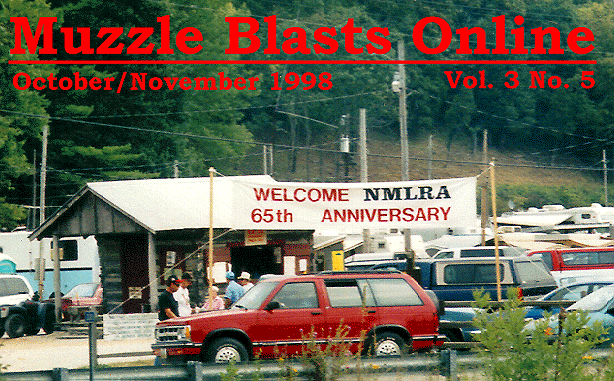
|
|
|
|
|
|
You Can Make A Difference
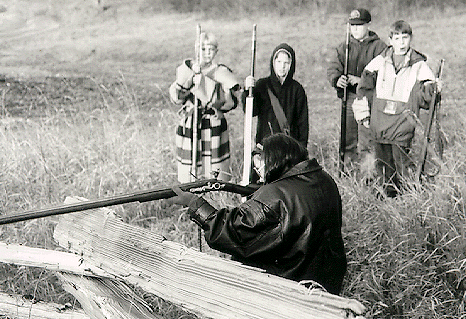
|
Rolling the pine block over in his hands, the Old One grins, and he speaks for the first time in ten minutes.
"Nice work. Now, what did you notice in the way of wildlife? Did you recognize that deer sign mixed in with turkey scat in the clover? Those bones are from a cougar-killed doe last May. That apple tree over there was topped by elk a couple of weeks ago. What do you figure we ought to do to protect it a little more?"
As the students drift off toward the browsed tree, everything is right with this picture. From the fur cap and pouches to the historic firearms they carry, you can sense the joy in this group. Only the footwear gives a clue to the time period they are in (Waugh, Nikes and Adidas!). They've earned these moments through their hard work, attention to safety, and a growing interest in life and the world. As they look down the slope across two thousand feet of elevation and six miles, their vision is lengthened and strengthened. They don't see just an awe-inspiring view, but are aware of a sense of direction and purpose that is being fostered within them. It's pretty hard to go back to mindless, eye-hand coordination video games when you've experienced a piece of the real world and the real action of life. This is quite an adventure, and it starts in the students' public school classroom.
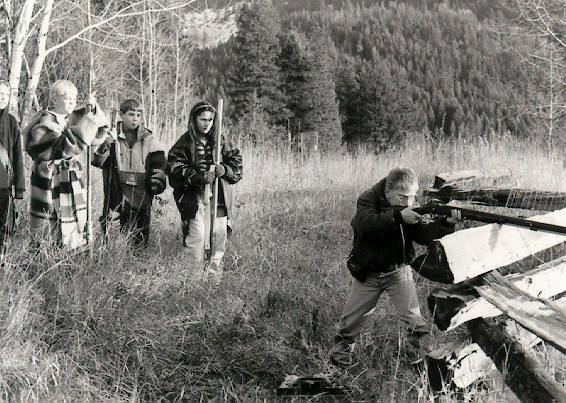
|
While most people are surprised to find such an environment, this assemblage is a self-contained fourth grade classroom in Washington's Kettle Falls Elementary School in northeastern Washington, several miles from the old Hudson's Bay Post, Fort Colville. This teacher admits to being a little closer to the ten-year-olds in mentality than his graying hair indicates. Every day is an adventure, and as he drifts down from the mountains every morning, he's glad to be a part of such a system. While some are surprised to see what others might view as tools of mayhem (the knives, axes, firearms, iron kettles, and fire-irons), every item has a very clear place. There is a vision of what is needed by today's youth. They need responsibility, trust, example, and self-discipline.
From my perspective as a teacher, I don't find any lacking in the strength of these students once they enter a real world. When confronted with expectations and offered a little direction, nine- or ten-year-olds have enough skills to really take off and make something of their lives. They, like us older folks, have to make a commitment to what is right and good. As a neighbor, parent, and/or teacher, we have to stretch ourselves. I'm blessed with a supportive wife, a good administration, and support from a thinking school board, my principal, and fellow staff. But parents and community are still the real key. Without their support, we are pretty much doomed to have a rough time in education. So much of what we do rests with others. Oh, we can limp through, but the students suffer and so does the community. Community members have so much to offer; and when they're involved, our students will turn into responsible and productive citizens. Many of us in historical reenactments have so much to share with our knowledge and collections. With our help, students can develop lifelong strengths and attitudes that will make sure our families, neighborhoods, states, and nation are safe, interesting, and wonderful places to live. I can speak of first-hand associations with many of you that have made a difference with many of my students.
Some are surprised to find firearms or knives in a classroom. Laws, both at the Federal and State level, still allow this for educational purposes. Your local school board and administration are the key to allowing knives and firearms into the schools within your district. Thank goodness for the people who have worked to protect our heritage against the inroads of those who would hide freedom, history, craft, art, sport, and technology. Often, people who would choose to take part in activities are put off by not knowing what the law really allows--teachers included. We are so busy trying to please everybody and stay within the laws that we hardly have a second to breathe and take a look at what is flowing down the pike next. We need your enthusiasm and expertise.
If you were to see a seventy-pound youngster with a couple pounds of hammer, focused on beating a piece of hot iron into something that resembles a tent stake or a tool, you'd know there was no worry that this kid or group will go off the deep end. They are focused. This is not cut and paste. They are creating a tool or an extension of themselves that they would never want to see taken away or destroyed. Nor, for that matter, would they want to see the loss of this opportunity and adventure from their lives. We have to remember that in times past, apprentices started their careers at this age. The collection of firearms being made for the local museum will always be a source of pride for these students. They researched and planned the pieces. They helped craft these arms, cast projectiles, and fired them. The artistic works they ply are all a source of gaining the confidence and discipline to tackle other projects or hurdles in life. When tanned hides become pouches, blades become tools for the kit, and horns become works of art. You can feel the beaming pride of accomplishment. Imagine for a moment what it feels like for a small person to share with adults the joy they feel. Don't you wish you had started in this direction a whole lot sooner? Take the vision you have and share it. Go the extra paces and they'll be miles in a short time.
I'm often asked how much time we spend on these projects. It varies according to how responsible the students are. Usually a limited group gets to work on a project a few minutes a day. Some days, we might spend a couple of hours as a large group working a hide, digging roots, researching, and writing. Other times it may only be a few minutes with a piece of brass, sanding and finishing. Moments when work is finished can be used by students on individual projects at their desks. We might walk over to the high school shop and blacksmith for an hour with one of their torches. (A portable, gas-fired, ceramic and stainless forge just walked into our room with a student from fifteen years ago as this article was being written. He built it to give something back. That surely was nice.) The high school shop is a place of mystery, and well, you can mix wee kids with giant kids. The small ones get a chance to see where they may be some day and start the inner process of planning for their own projects. The big kids can be role models and reflect a bit on how far they've come.
If you are interested in sharing such activities with a class, start small. We always start with cooking in Dutch ovens, usually on the sidewalk outside the classroom door. We also practice our fire starting skills with flint and steel there as well. Moving out into a corner of a lawn, we cut a divot and build a fire pit, complete with irons and grates that were made by the students. Cook anything -- breads, pies, meats, (baked, broiled, boiled), soups, stews, vegetables, cobblers, etc.
Classroom projects--beading and the making of pouches, pattern making, and research--are all relevant to subject areas such as art, mathematics, English, science, history, reading/library, etc. These are usually done at the students' desks or in small groups. These can be extra or part of a specific course of study.
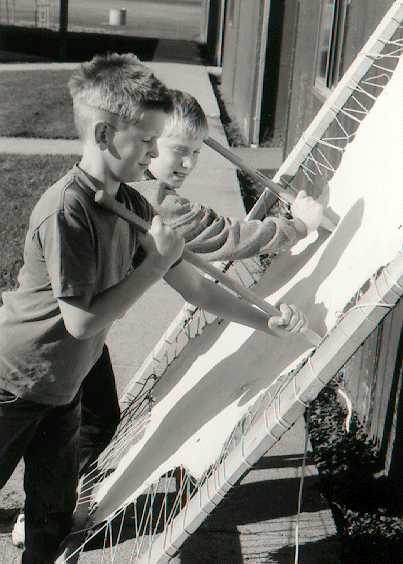
|
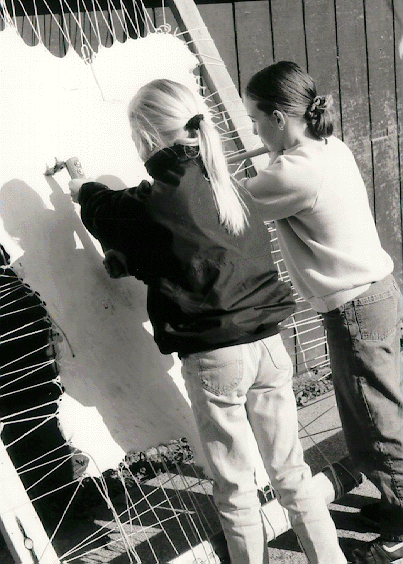
|

|
For firearms construction, parts can be ordered for assembly. You can also build what you are capable of. We work and cast in the high school shop, or work with lead and pewter in the area outside the classroom. Bullets are cast outdoors, most often with an electric pot. A bench in the classroom has several vises for holding parts. Tools remain simple, in the realm of hand operated. A drill is about the only power tool used; however, now and again a electric buffer in the high school art room comes into play. The tools used most frequently are files, chisels, scrapers, and sandpaper.
Safety is taught before and during ongoing projects. Goggles, ear protection, shooting glasses, and leather welding gloves are important pieces of equipment. Students police each other in this arena pretty well. They are proud to know the correct way of doing things. Use sharp, good quality tools and show the students tricks for keeping things in good condition. No really large investment is needed. Often high school shops will help you out at the elementary school level with tool loans or the construction of benches. Your work pays dividends for them later on.
When it comes to finishing projects, sandpaper is pretty cheap, and a lot of tools can be made with doweling or wood scraps to work small areas. Chemicals, oils, and stains will need a container for storage if some area isn't available close at hand. You might even carry them back and forth with you if you're on a project with a group. One of the millwrights in town built us a steel locking box that sits under our work bench; we use it for valuable tools. We've built wooden chests to hold other items in the classroom, and they've also proven valuable in transporting equipment to outside locations. Nineteen-dollar poly footlockers from local stores are a good value as well. Theft has never been a problem, as students would never want to ruin the good things they got to do. You'd be more apt to lose your lunch around here. Trust is a very important point in dealing with all people in life, and kids learn behavior from the way they are treated. Expect honesty and offer trust. It's wonderful to see the returns you get for such a small consideration. Think positive, and if things go awry, you hold the greatest leverage of all: shutting down the project. If someone ever acts reckless, they don't have to be involved. Remember, you are not on a power trip, but you are in control.
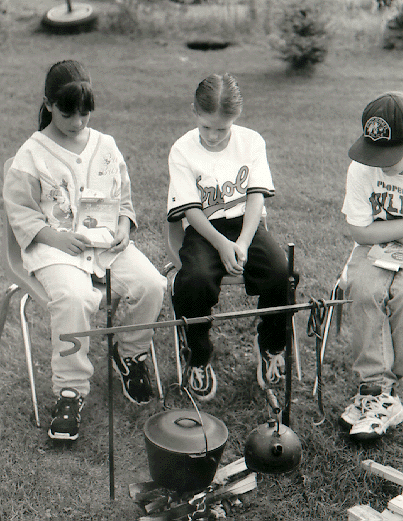
|
One thing that has proved very popular is a camp-out at the end of the year. The boys stay out one night, girls another. Parents are needed for this, and it's never been a problem to get volunteers. Tents have been made and collected over the years. Most of us don't have the cash flow to jump in whole-horse at the onset of an idea, so things trickle in, getting better and greater in proportion to the length of time we're involved. Local merchants will help out at times, but won't know if not asked. The Alcoa Foundation supported us with a nice tent a few years back and it was much appreciated. Grants are available from a large number of sources, but you have to do the leg-work. Remember, to steal ideas from one person it plagiarism; to steal from many is research.
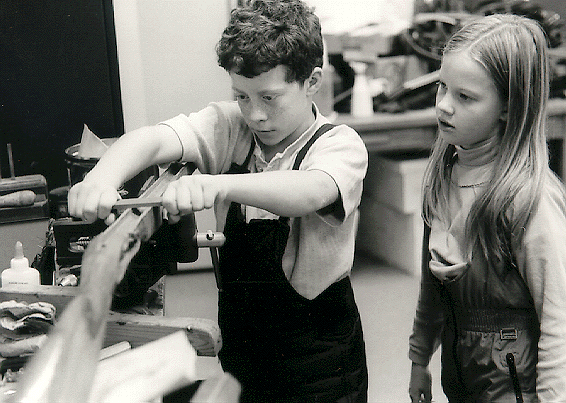
|
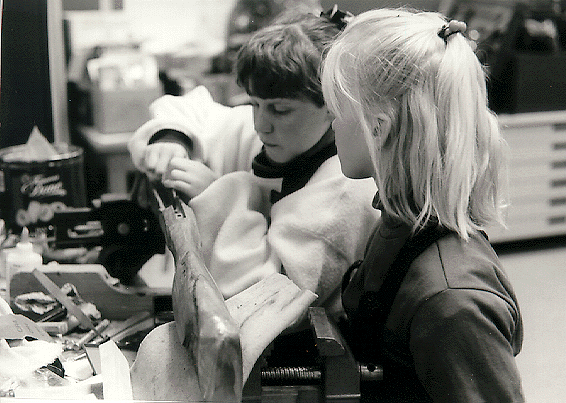
|